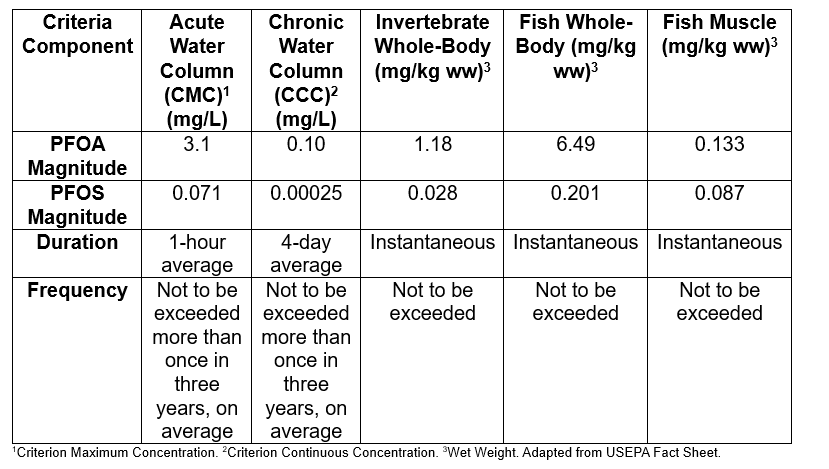EPA PFAS Aquatic Life Criteria: Implications for NPDES Discharge Permits
Lorin Hatch, Senior Water Quality Specialist
Lorin has developed and applied water quality solutions to multiple business sectors for over 30 years, including water, wastewater, environmental, transportation, hydropower, mining, remediation, water resources, power and energy, and the federal government to name a few. He works with clients to create cost-effective solutions to address their water quality problems, both with their current issues, but also with an eye towards future issues that can impact the client.
For decades, synthetic compounds collectively known as PFAS have been used in manufacturing due to their unique properties. However, many PFAS pose a risk to human health and the environment. Initial efforts to establish enforceable government PFAS criteria pertaining to human health have focused on drinking water. For example, in April 2024, the USEPA released an enforceable drinking water standard of 4.0 ppt for PFOA and for PFOS, two of the major compounds in the class of over 10,000 PFAS. Focusing beyond drinking water, we consider here the aquatic life criteria to address surface water quality released in 2024 by the USEPA for certain PFAS.
USEPA’s PFAS Aquatic Life Criteria will impact NPDES Discharge Permits
The USEPA’s final recommended aquatic life criteria and benchmarks for select PFAS compounds were released in September 2024 with lower concentrations than originally proposed in 2022 draft criteria.
This will directly affect industrial and municipal wastewater dischargers operating under National Pollution Discharge Elimination System (or NPDES) permits. Recent NPDES renewals have called for PFAS monitoring, but, as yet, enforceable limits for discharges have not been incorporated into any Federal or State permits. Upcoming NPDES permit renewals are likely to include PFAS sampling and may impose the new discharge criteria. This would require dischargers to address PFAS levels in their effluent through enhanced mitigation measures.
USEPA’s Criteria and Benchmarks
Criteria are based on constituents that have an adequate amount of data and toxicity testing to make a robust recommendation. Benchmarks apply to constituents where limited high quality toxicity data are available and data gaps exist.
For freshwater, recommended criteria for PFOA and PFOS include acute and chronic water values, as well as aquatic invertebrate whole-body, fish whole-body, and fish muscle values. These values are presented below:
Table 1. Final Recommended Freshwater Aquatic Life Criteria for PFOA and PFOS

Saltwater acute benchmarks for PFOA and PFOS in water have also been developed and are presented below:
Table 2. Acute Saltwater Aquatic Life Benchmarks for PFOA and PFOS

Finally, freshwater acute benchmarks for eight additional data-limited PFAS compounds have been developed for water and are presented below:
Table 3. Acute Freshwater Aquatic Life Benchmarks for Eight PFAS

Impact on State Regulations
While these PFAS criteria and benchmarks are not immediately enforceable, they represent starting points for States and Tribes to develop their own water quality criteria or serve as support for those already in development. It is likely that many states will adopt these recommendations directly, as developing independent criteria would require substantial investment in time, budget, and staffing resources.
Table 1 includes criteria for aquatic invertebrates and fish as well as water criteria. These organisms may be exposed to PFAS compounds via direct water contact or food and prey. PFAS discharge into waterbodies may occur via groundwater, streams or atmospheric deposition. These organisms may experience acute or chronic toxicity, as well as impaired growth, development, and reproduction. Humans and animals can be exposed to PFAS by consuming fish containing PFAS.
Typical PFAS Levels in Freshwater Fish
Data from the USEPA National Rivers and Streams Assessment (2013 - 2015, n = 349 fish samples) and the USEPA Great Lakes Human Health Fish Fillet Tissue Study (2015, n = 152 fish samples) provide examples of PFAS levels in freshwater fish from across the United States. These two studies yielded median fish whole-body PFOS concentrations of 0.00951 mg/kg (25 - 75 percentile: 0.005034 - 0.024844) and 0.017765 mg/kg (25 - 75 percentile: 0.008478 - 0.027360), respectively. The recommended USEPA PFOS criterion for fish whole-body in Table 1 is 0.201 mg/kg, much higher than indicated in the referenced studies. This suggests that finding fish in U.S. freshwaters with whole-body concentrations higher than the PFOS tissue criterion is likely uncommon, however, the available fish tissue dataset was very limited. It is likely that fish have higher PFAS concentrations than these studies presented, particularly in smaller waterbodies with significant PFAS contamination sources.
Impacts to Wastewater and Industrial Facilities
Once a State finalizes its surface water PFAS aquatic life criteria, wastewater and industrial facilities with NPDES discharge permits will need to respond. For facilities where PFAS investigations are currently taking place in a receiving stream or lake, there will likely be a need for future waterbody and fish PFAS sampling. A government agency might also sample water or fish from a waterbody near to a facility where PFAS compounds are expected to be released due to manufacturing or waste processes.
Facilities with the potential to release PFAS into nearby surface waters would be wise to assess the need for water and fish testing. Early sampling can help prepare for potential mitigation or cleanup responsibilities.
AECOM’s PFAS Evaluation, Mitigation and Management Experience
AECOM is a leader in the study and mitigation of PFAS. Our hundreds of scientists and engineers across the globe have been conducting PFAS investigations since 2001, actively innovating methods to identify and resolve PFAS for our clients. These newly released PFAS criteria and benchmarks represent another step towards protecting and remediating our environment. Our experienced team is ready to meet that challenge.
Learn more about AECOM’s PFAS capabilities: https://publications.aecom.com/pfas/
Contact
Contact us at askenvironment@aecom.com for assistance
Reference Materials:
USEPA National Rivers and Streams Assessment: https://www.epa.gov/national-aquatic-resource-surveys/nrsa
USEPA National Coastal Condition Assessment’s Great Lakes Humans Health Fish Tissue Studies: https://www.epa.gov/fish-tech/national-coastal-condition-assessment-great-lakes-human-health-fish-tissue-studies